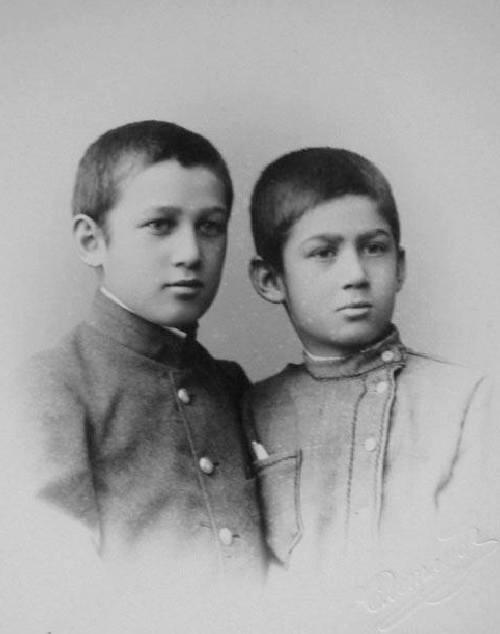
Russian Boys' Garments: Suits

Figure 1.--These two brohers were photographed in 1888. There names were Jean and Serge, but unfortunately we do not know his family name. Note the one boy wearas a collar buttoning jacket that buttons down the middle. It might be a school uniform. His brother's jacket is off set to the side and might be classidied as a Russian blouse. Notice here that it is being worn instead as a suit jacket.
|
|
Russian boys wore a range of suit types. Our information is limited, but many of them were the same basic styles as worn by other European boys. Suit and other clothing styles were largely set in Western Europe. This was especially true in the 19th and early 20th century. One exception was the Russian-blouse. This could be worn instead of a suit jacket. We know less about the 20th century. This is because after World War I, the Soviet Union was established. Soviet authorities based on Communist ideology, discouraged fashion. It was seen as a Western bourgeois dalliance. Od course fashion is as old as humanity. Thus the Soviet authorities were weiging against a basic thred of human nature. Clothing manufacturers were nationalized as part of Soviet economic policy. Soviet authorities limited both wages and the acialability of consumer goods such as clolthing. Soviet manufactuers no longer had to respond to consumer demand. And shortages of consumer goods meant that Russians had to be satisfied with whatever was available. Another factor was the relative poverty of Russia during the Soviet era, especially before World War II. Russia even at the time of World War II was still a larely rural country although the cities had grown with industrial expansion. Many boys except in the major cities probably did not have suits. This changed after the War when living conditions improved, although were still far below standards in the West. And this was reflected in children's clothing.
Our information on Russian suits is limited, but many of them were the same basic styles as worn by other European boys. We know less about the 20th century. This is because after World War I, the Soviet Union was established. This complicated the largely chronological pattern that we follow in most countries. Soviet authorities based on Communist ideology, discouraged fashion. It was seen as a Western bourgeois dalliance. Od course fashion is as old as humanity. Thus the Soviet authorities were weiging against a basic thred of human nature. Clothing manufacturers were nationalized as part of Soviet economic policy. Soviet authorities limited both wages and the acialability of consumer goods such as clolthing. Soviet manufactuers no longer had to respond to consumer demand. And shortages of consumer goods meant that Russians had to be satisfied with whatever was available. Another factor was the relative poverty of Russia during the Soviet era, especially before World War II. Russia even at the time of World War II was still a larely rural country although the cities had grown with industrial expansion. Many boys except in the major cities probably did not have suits. This changed after the War when living conditions improved, although were still far below standards in the West. And this was reflected in children's clothing.
Russian boys have wore a range of suit types. Suit and other clothing styles were largely set in Western Europe. This was especially true in the 19th and early 20th century. Skeleton suits were the first suits worn. We see lapel jacket suits in he 1830s. A good exmple is Prince Nikolay Yusupov (1839).
We don't see any notable Russian suit sytles, only the same basic styles as worn in Western Europe. A large part of the Russian population lived in the countryside and until 1861 were serfs, esentially medieval peasants. Few serfs had Western garmehts like suits. Their cgaacteristic garments becameknown as a Russian blouse and many Russian boys eben in the city negan wearing thesevgarments. Here we see a boy wearing a Russian vlouse suit bwhie his brither wears a suit jacke (figure 1). Russian blouse suits at the turn-of-the 20th century even became popular in the West, a alternatuve for a formal suit for a younger boy. This gradually went out of style after the Revolution, apparently a rejection to traditiinal clothes by the Stalinist authorities. At the same time Stalin was supprssing the peasabtry and collectiving agriculture. We mostly see booys wearon stndard suits as the Soviet Union recovere \d from the tragedy of World War II. We see boys wearing suits to school for a while jackes with militaet touuches. We nostly see navy blue jackets. We see some stylish suits, but we ae unsure hiw common they were.There were fashion magazines, but he style depicted were often not available in the stoes. And their was nothing like the Sears and Montgomery wards catalog. Mostly we see stanfard single=breased jackets for boys.
Garments
HBC

Navigate the Boys' Historical Clothing Web Site:
[Introduction]
[Activities]
[Biographies]
[Chronology]
[Clothing styles]
[Countries]
[Topics]
[Bibliographies]
[Contributions]
[FAQs]
[Glossaries]
[Images]
[Links]
[Registration]
[Tools]
[Boys' Clothing Home]
Navigate the Historic Boys' Clothing Russian pages:
[Return to the Main Russian garment page]
[Ballet]
[Children's literature]
[Choirs]
[Fashion magazines]
[Movies]
[Royalty]
[School uniform]
[Youth groups]
Navigate the Boys' Historical Clothing Web Site:
[Return to theMain country page]
[Australia]
[Canada]
[England]
[France]
[Germany]
[Ireland]
[Italy]
[Mexico]
[New Zealand]
[Poland]
[Russia]
[Scotland]
[United States]
Created: 9:21 PM 5/22/2008
Last updated: 4:41 AM 8/7/2019



